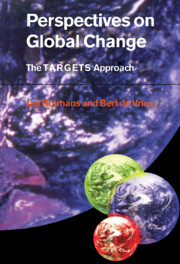Book contents
- Frontmatter
- Contents
- Foreword
- Preface
- 1 Global change and sustainable development
- Part One The TARGETS model
- Part Two Exploring images of the future
- 11 Towards integrated assessment of global change
- 12 Population and health in perspective
- 13 Energy systems in transition
- 14 Water in crisis?
- 15 Food for the future
- 16 Human disturbance of the global biogeochemical cycles
- 17 The larger picture: utopian futures
- 18 Uncertainty and risk: dystopian futures
- 19 Global change: fresh insights, no simple answers
- References
- Acronyms, units and chemical symbols
- Index
19 - Global change: fresh insights, no simple answers
from Part Two - Exploring images of the future
Published online by Cambridge University Press: 06 July 2010
- Frontmatter
- Contents
- Foreword
- Preface
- 1 Global change and sustainable development
- Part One The TARGETS model
- Part Two Exploring images of the future
- 11 Towards integrated assessment of global change
- 12 Population and health in perspective
- 13 Energy systems in transition
- 14 Water in crisis?
- 15 Food for the future
- 16 Human disturbance of the global biogeochemical cycles
- 17 The larger picture: utopian futures
- 18 Uncertainty and risk: dystopian futures
- 19 Global change: fresh insights, no simple answers
- References
- Acronyms, units and chemical symbols
- Index
Summary
Introduction
We know that the future is inherently uncertain, yet we are fascinated by insights into ways in which we may be influencing the planet. This interest is intensified because there is widespread perception that the world is changing at an unprecedented speed. Undeniably, many parts of the global system are accelerating or decelerating compared to previously observed, natural rates of change. For some people these processes of change may just look like more of the same. There are, however, underlying behavioural and structural changes at work which suggest deeper, more radical change in the longer term. Many of those long-term changes can be viewed as part of transition processes. Several of these are within the human system: from many to 1 or 2 children per family, twice as many older people per thousand compared to today, a factor of 3 to 5 less energy and water use per unit of economic activity, increasing pressure to cultivate more land and use it more intensively to feed the population. More gradual, but possibly of overriding importance, are the changes in the environmental system, such as the accelerating increase in the concentration of some atmospheric gases and increasing accumulation of pollutants in soils and water bodies which are the result of past and present practices. It is difficult to disentangle the human-induced, structural long-term changes from the natural changes, which makes it even harder to see where the world is heading.
- Type
- Chapter
- Information
- Perspectives on Global ChangeThe TARGETS Approach, pp. 417 - 434Publisher: Cambridge University PressPrint publication year: 1997
- 1
- Cited by

